
Even viewers who claimed to despise soap operas could find a soft spot in their heart for Dark Shadows, television’s first unequalled great ‘ghost opera’. In part, this soapie had others beat because, if a character was killed off, there was no need to concoct a lengthy explanation to justify their return – they would just come back as a ghoul, or vampire, or whatever creature the writers wanted. The series took full advantage of its supernatural environment during its five-year run, having werewolves, a monstrous couple, and characters traveling back in time, or to a parallel time, at various periods. Along the way, it spawned a popular song, a successful line of books and comics, and a cult following which is still holding conventions with members of the cast five decades after the show began. There are very few daytime soaps that can claim such distinction. Despite later claims to the contrary, the ABC network and producer-creator Dan Curtis knew from the very beginning that the show was going to be about ghosts and goblins, and promoted it that way among the trade press.
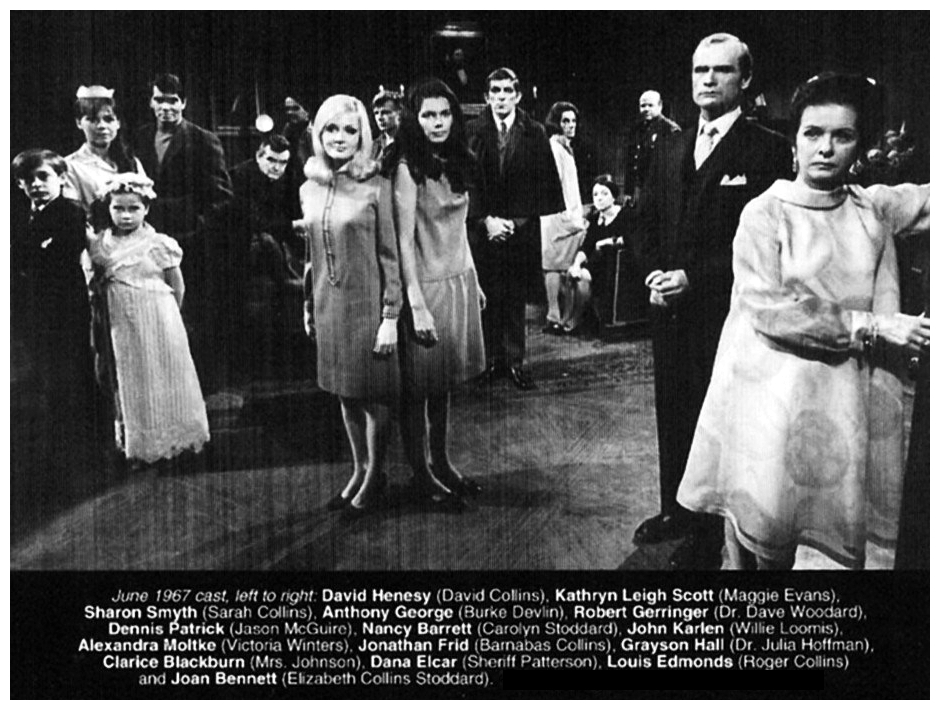
The eerie mood was certainly set in the very first episode, when Victoria Winters (Alexandre Moltke) arrived as a governess for young David Collins (David Henesy) at the coastal town of Collinsport, Maine. Waitress Maggie Evans (Kathryn Leigh Scott) told Victoria she was a total jerk for working with the family, warning Victoria of the mysterious reputations of David’s father Roger (Louis Edmonds), his older sister Elizabeth (Joan Bennett), Elizabeth’s daughter Carolyn (Nancy Barrett) and their housekeeper Sarah Johnson (Clarice Blackburn), all of whom lived in the gloomy manor of Collinwood. The more sedate Maggie lived with her widowed father Sam (David Ford) and had a boyfriend named Joe Haskell (Joe Cruthers). Adding to the intrigue was beefy Burke Devlin (Mitchell Ryan & Anthony George), who became Victoria’s fiancee as he vowed vengeance on Roger Collins for supposedly framing him and sending him to prison many years before. Then the macabre events began.

Barnabas was a vampire who intended to abduct Maggie because she looks just like his eighteenth-century wife Josette DuPres. With the help of Willie, now his servant, Barnabas kidnapped Maggie and planned to marry her before she escaped to Windcliff Sanitarium. A doctor there, Julia Hoffman (Grayson Hall), became intrigued with her story and went to Collinwood to investigate its validity. She would spend the rest of her run in a tangled effort to undo the curse on Barnabas while coping with her growing affection for the vampire. At first she was not successful, and Barnabas stopped his reign of terror (for a few episodes anyway) only when he saw the ghost of his little sister Sarah Collins (Sharon Smyth). Then a seance held at Collinwood transported Victoria Winters back to 1795, where she learned of how Barnabas had lost Josette due to a hex from an envious witch named Angelique (Lara Parker). Angelique then died and Victoria was tried as a witch by the cruel Reverend Trask (Jerry Lacy). When she returned to the present, Victoria was haunted by her memories and eventually went insane.
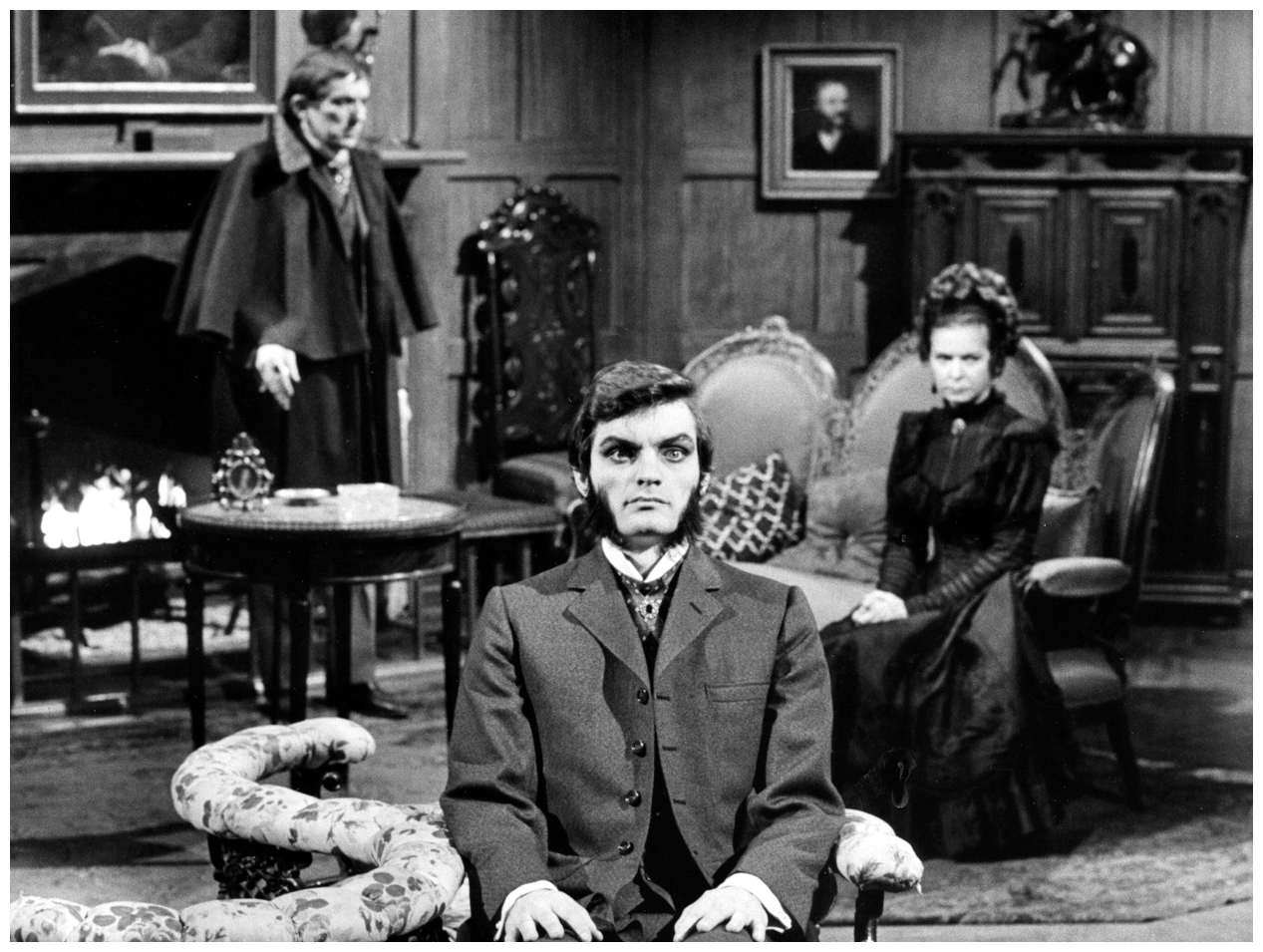
Maggie assumed the governess role, but the events of the past had implications for the present, as Collinsport in 1968 found itself swarming with creatures of the night. Angelique arrived at Collinwood disguised as Roger’s new wife Cassandra to hound Barnabas, who was now being treated for his vampirism by Doctor Hoffman and Doctor Eric Lang (Addison Powell). Lang had created an artificial man named Adam (Richard Rodan) before dying. Adam got a mate named Eve (Marie Wallace) courtesy of the influence of warlock Nicholas Blair (Humbert Allen Astredo), but eventually killed her. Blair, on the other hand, transformed Angelique into a vampire to menace Barnabas. To round out the year, Amy Jennings (Denise Nickerson) came to live at Collinwood and brought her werewolf brother Chris (Donald Briscoe), whose twin brother Tom (also Donald Briscoe) became a vampire thanks to Angelique. Amy and Chris used a disconnected telephone to summon Quentin Collins (David Selby) from 1897, who arrived in town in late 1968 after an unsuccessful attempt to possess his descendant David.

Quentin merited his own story the following year, when Barnabas went back to 1897, learning how Quentin became a werewolf, as well as other details about his family’s past. This was the first of several sequences that took place during Dark Shadows‘ final two years, in which Barnabas either travelled back through time, or the characters experienced ‘parallel time’. The parallel-time sequences depicted what would have happened to characters had different choices been made. For example, Barnabas and Julia saw a parallel 1995, and realised how dreary Collinwood would be if they did not change the past and, in an 1840 sequence, Barnabas fought Angelique one last time and had his own son Bramwell (Jonathan Frid) fall in love with Catherine Harridge (Lara Parker), with the latter being able to break the supernatural curse of the Collins family. During these sequences, actors on Dark Shadows usually played the ancestors of their characters, their ghosts or whatever the plot required of them.
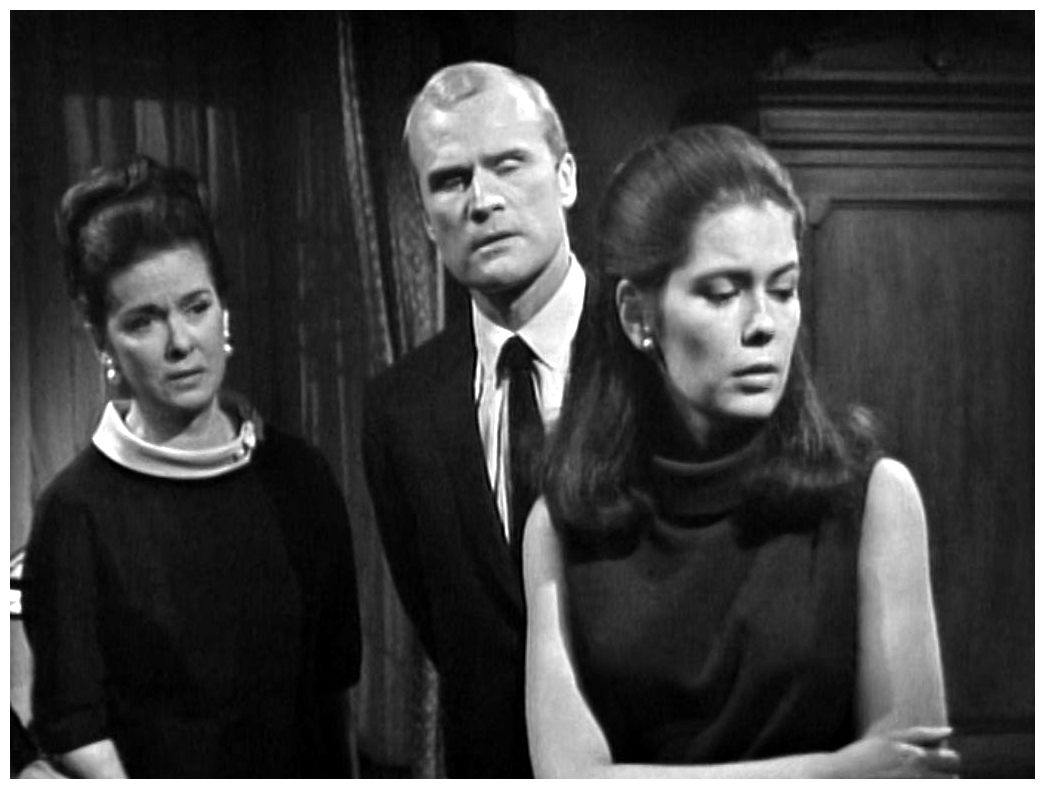
I’ve only listed the most frequently seen characters and actors – Thayer David, for instance, also played Ben Snokes, Sandor Rakosi, Count Petofi, Mordecai Grimes and others. The show also had a reputation for bloopers, the on-camera gaffes that seemed to blossom on this soap more than any other, even though Dark Shadows was videotaped while many others were still being broadcast live. This was partly due to the ABC‘s attempt to cut costs by refusing to do retakes, and partly to the relatively expensive special effects used on the show, which added to an already hectic pace. Whatever the reasons, there are so many shots of microphones entering the shot, props going awry and scenery falling apart, that there was actually a pirated videotape released on the market composed exclusively of the show’s mistakes. The mystique that attracted so many dedicated viewers remained powerful right up to the end, even though younger viewers were showing a preference for Gomer Pyle reruns on CBS, which eventually led to the sad demise of Dark Shadows.
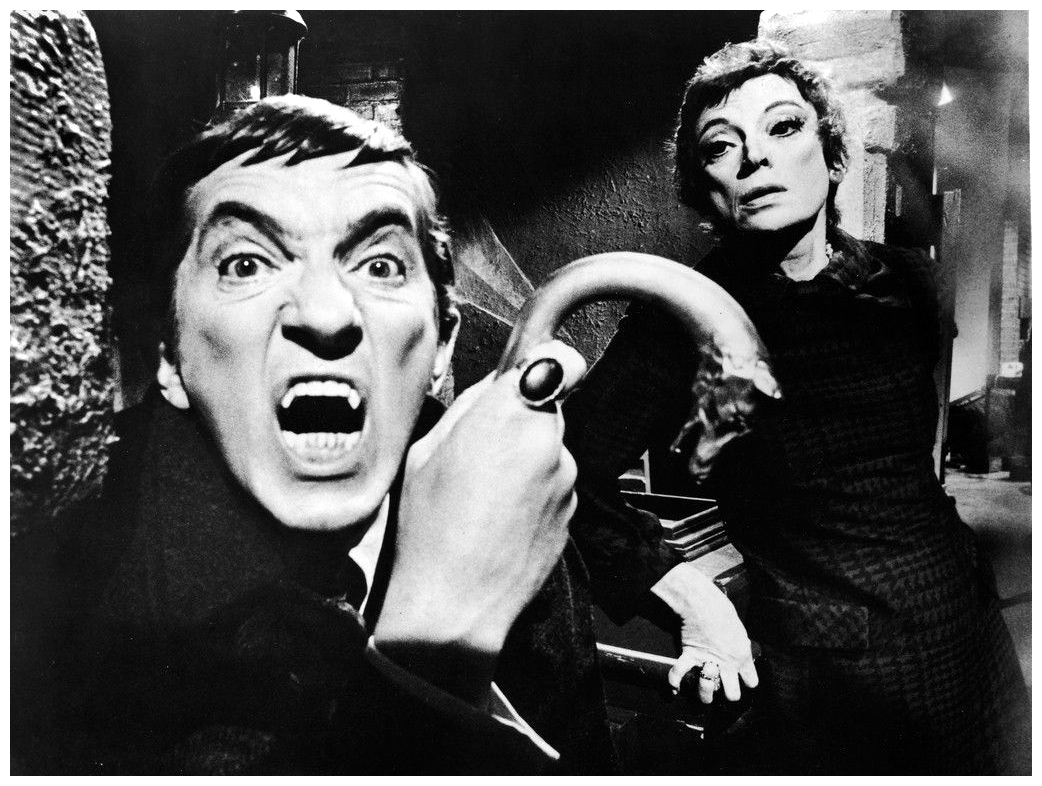
One letter to TV Guide magazine stated, “Our television set is turned off this 4pm in mourning for the passing of the most fabulously innovative afternoon program ever to have graced TV – Dark Shadows – that exquisitely mounted and star-adorned daily feast for the yes. We are bereft. I am grateful to ABC for the beauty (some scenes were Rembrandts in motion) and the fantasy (a delightful way to unwind after a battle with a prosaic world) and the inspired casting.” TV Guide also found that many readers were seriously interested in the unresolved story-lines, so they hired head writer Sam Hall to write an article on how he had planned to wrap them up: Elizabeth Collins would remarry; David Collins would take over the estate; Quentin would be treated for being a werewolf; Carolyn Stoddard would be left a widow by Jeb Hawkes (Christopher Pennock); Maggie Evans would divorce Philip Todd (Chris Bernau) and marry Joe Haskell; Angelique would kill Roger Collins, who would then become a ghost; Joe Haskell would lose his memory after his stint at the Sanitarium; Chris Jennings (Donald Briscoe) would become a werewolf, kill Sabrina Stuart (Lisa Richards) and then commit suicide; and Doctor Julia Hoffman cures Barnabas of his vampirism so that they can marry and leave Collinsport forever.
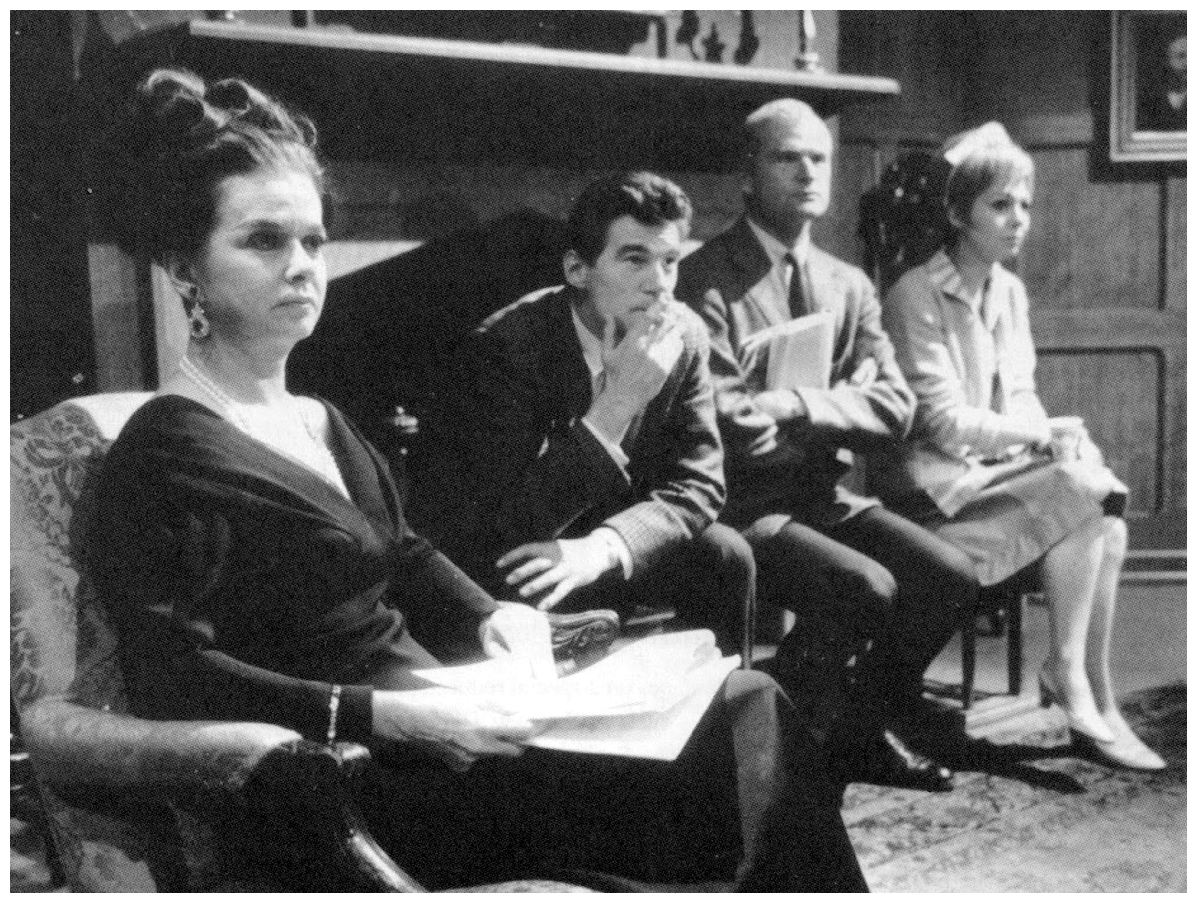
In other words, a ghost story with a happy-ever-after ending. After its cancellation, Dark Shadows aired sporadically in syndicated reruns during the seventies and eighties, the first network soap opera to air in that format. In 1989 the show had the first of its 1,245 episodes released on videotape, and it was also the first show to be purchased by the Sci-Fi cable channel and started running on that network daily in 1992. Books on the series proliferated as well, with perhaps the best being The Dark Shadows Almanac, edited by Kathryn Leigh Scott and Jim Pierson and published in 1995 by Pomegranate Press. Just like its characters, Dark Shadows was enjoying life after death. Nothing in my bare plot synopsis indicates the notable effect this series had on popular culture during its run. Quentin’s Theme (also known as Shadows Of The Night), a light instrumental tune composed by Robert Cobert featuring the celeste piano recorded by Charles Randolph Grean, became a surprise hit in 1968, cracking Billboard Magazine‘s Top 20 singles chart, the first for a song from a soap opera.
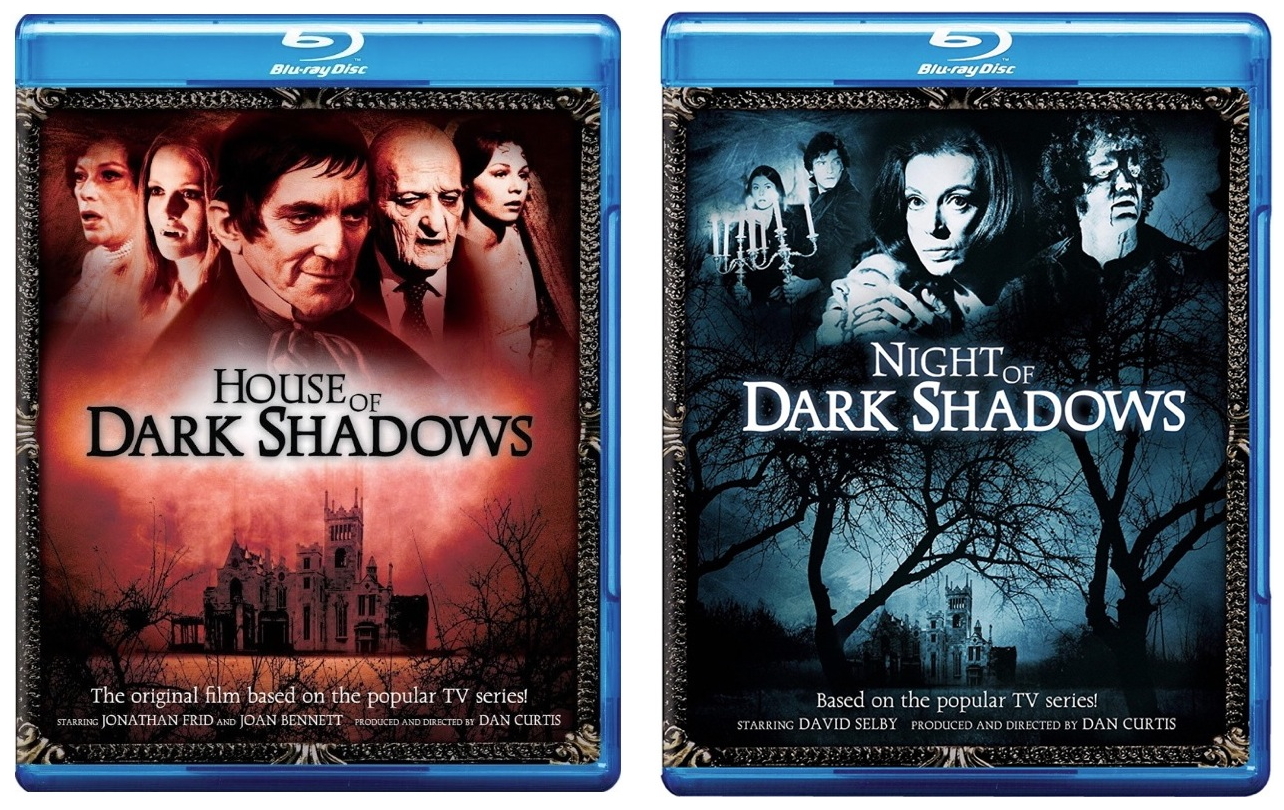
Another soapie first was it spawned two feature film spin-offs – House Of Dark Shadows (1970) and Night Of Dark Shadows (1971). Producer-creator Dan Curtis began pitching the idea for a film based on his gothic soap opera in 1968, and was finally given a green-light by MGM in 1970. Curtis’s original idea had been to edit together footage from the television series into a feature-length film, an idea which was quickly abandoned because the videotaped shows looked absolutely awful on the big screen. Curtis decided to use the original Barnabas storyline as the basis for the film, but with a modified conclusion. The TV show was still in production while the film was being made, and some characters had to be temporarily written out of the show so that the actors would be available to appear in the movie (for example, in the TV show, Barnabas was trapped in his coffin by a failed novelist who wanted to use the vampire’s life story as the basis for a book).
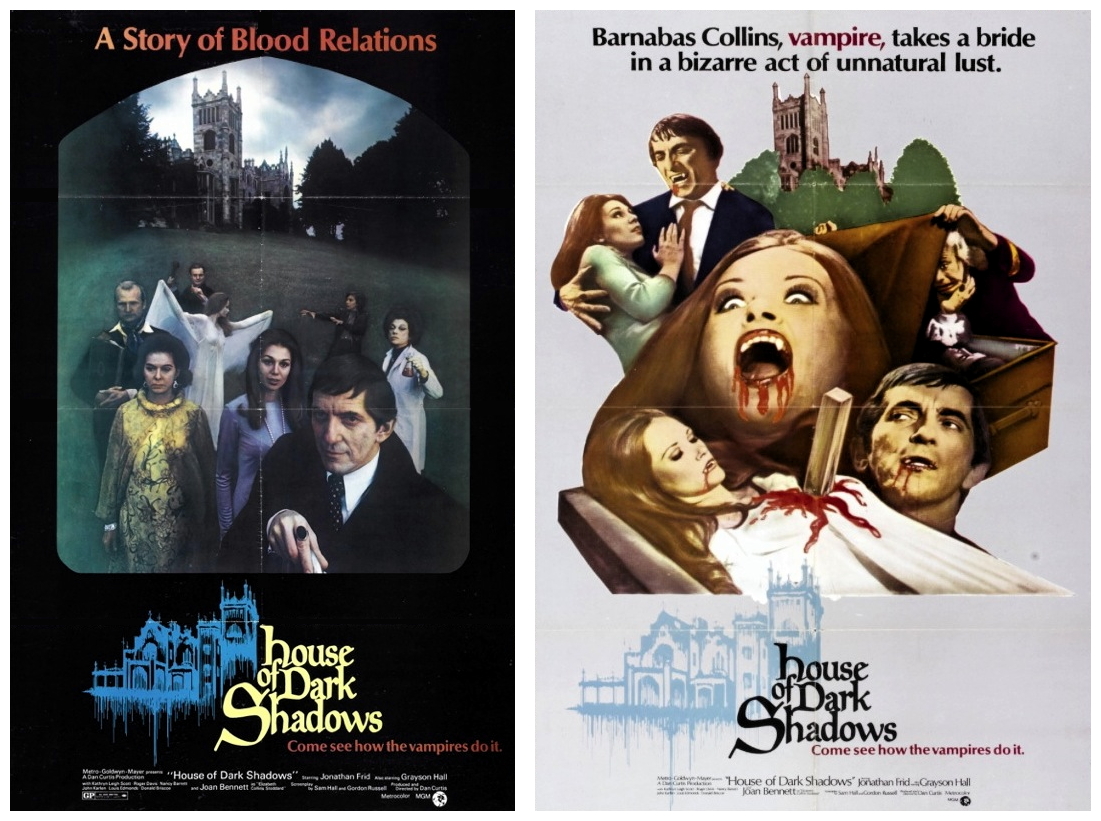
Unrestricted by TV censors, the films had a lot more blood and guts than their television counterpart, and House Of Dark Shadows (1970) was released at the height of the show’s popularity to great box-office success. The result was an effectively creepy little horror film done with some style, about a 200-year-old vampire (Jonathan Frid) who is released from the crypt of an old mansion and tries to find a cure for his affliction. Despite a few awkward moments in the photography and editing (tell-tale signs of hasty shooting and lack of budget) the result was considered to be one of the best horror films of the year, warranting a sequel to be released the following year.
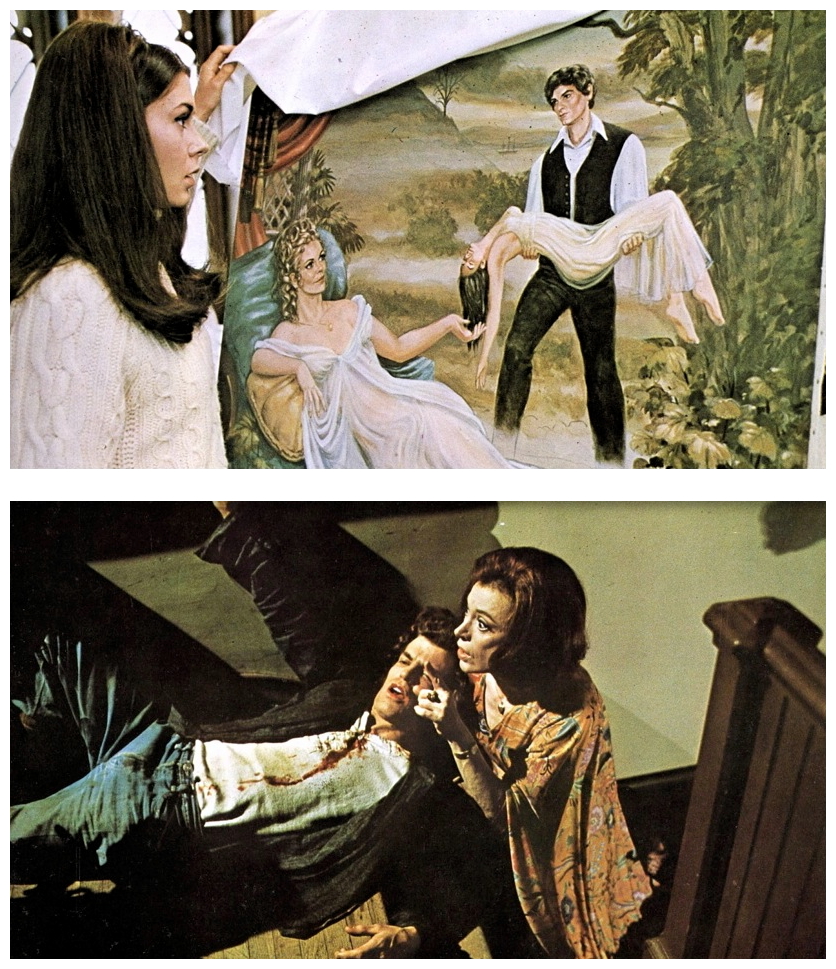
Sadly, Night Of Dark Shadows (1971) doesn’t feature Barnabas at all, but concentrates instead on Quentin Collins (David Selby) who, after moving to his ancestral home of Collinwood with his wife Tracy (Kate Jackson), begins to experience strange and violent visions of the past. After the success of House Of Dark Shadows, MGM was ready to back a sequel, and Curtis wanted Barnabas back in the lead. Actor Jonathan Frid, however, feared typecasting and refused to play the role again. Instead Curtis worked with writer Sam Hall to concoct a completely new story, a wistful tale of gothic romance and supernatural reincarnation. When it came time to edit the film, it proved to be far more complex than the first film, so MGM forced Curtis to cut his 129 minute film down to 94 minutes, and gave him only 24 hours to do the job. Needless to say, the sequel bombed at the box-office, despite strong performances from the two leads, Selby and Jackson, in their feature-film debuts.
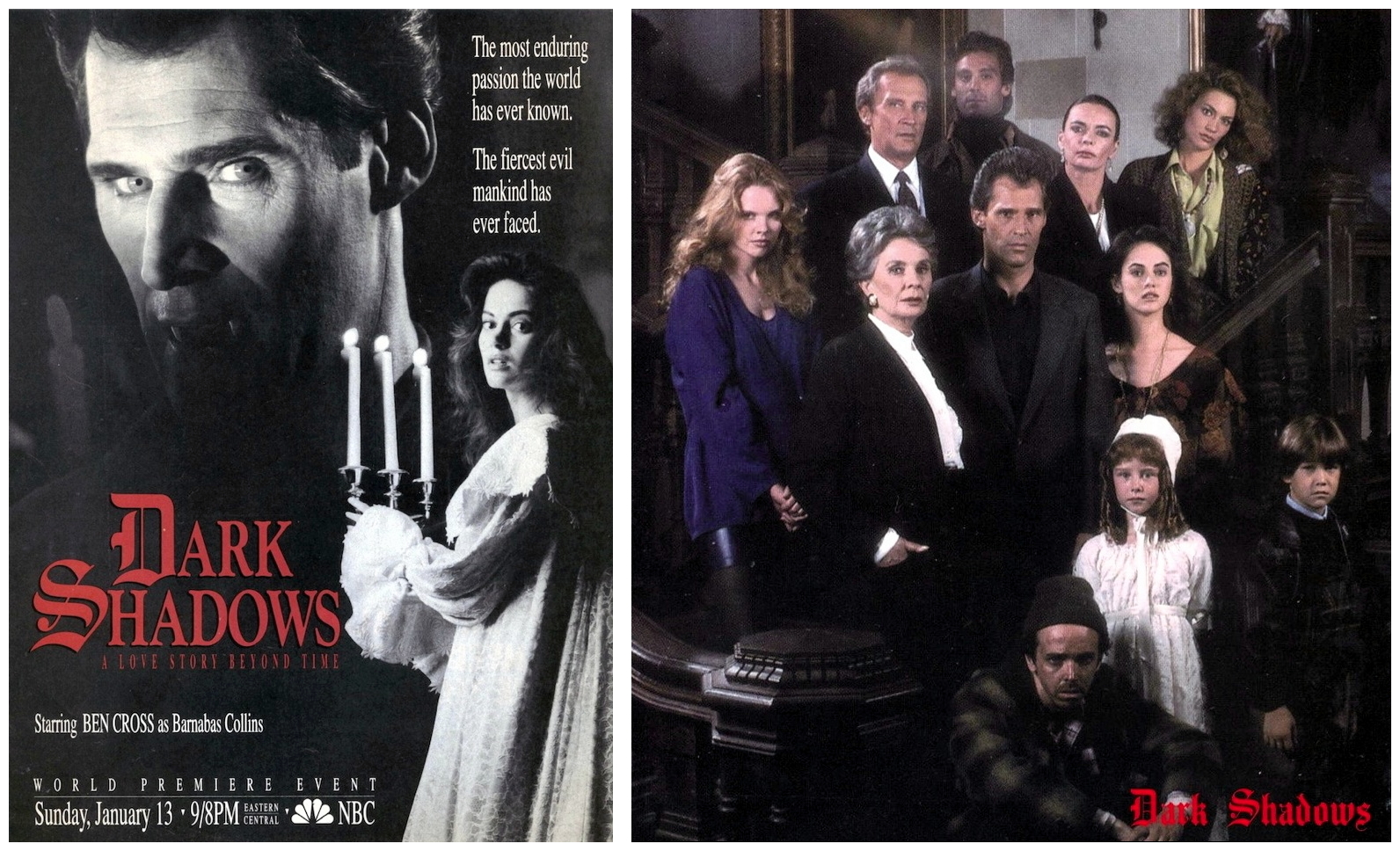
Two decades later, Dark Shadows also became the first daytime soap to be revived in a primetime evening slot when the NBC network attempted a belated recreation with the same title in 1991. This modern-day reboot begins when Willie Loomis (Jim Fyfe), the lurching dimwitted groundskeeper at the musty Collins estate in seaside Collinsport, Maine, opened the family crypt during a treasure hunt. Big mistake. Out crawled Barnabas (Ben Cross), the family’s 200-year-old vampire, who dusted himself off and began feeding on the local townspeople – particularly beautiful women – by night. By day, he passed himself off as a long-lost relative recently arrived from England. Barnabas was an unhappy vampire, however, who longed to be rid of his curse. Doctor Julia Hoffman (Barbara Steele) discovered his secret and promised to help him, producing a serum that reduced his bloodlust – a little – and even let him walk in the sunlight and show a reflection in a mirror.
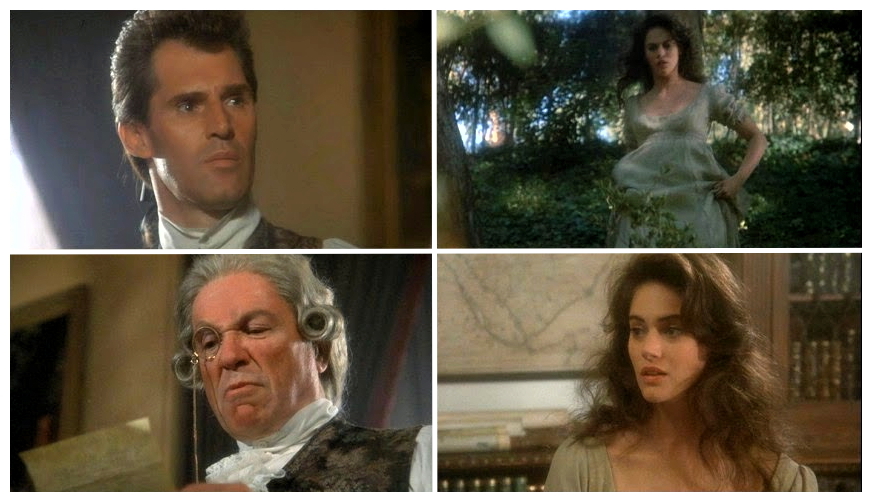
Julia loves him, of course, but a triangle develops because his heart really belongs to a young family governess named Victoria (Joanna Going), a dead-ringer for his beloved Josette, whom he had loved and lost two centuries before. Elizabeth (Jean Simmons) was the aristocratic matriarch of Collinwood, Roger (Roy Thinnes) was her brooding brother, and David (Joseph Gordon-Levitt) was Roger’s incorrigible son. After a few episodes, the action began to alternate between Collinsport in the present day and in 1790, when most of the principal characters seem to have alter-egos. Angelique (Lysette Anthony) was the eighteenth-century witch who lusted after Barnabas and caused a great deal of trouble, while Barnabas’s modern-day nemesis Professor Woodward (Stefan Gierasch) turned out to be his father two centuries earlier. The 1991 version of Dark Shadows focused almost exclusively on the character of Barnabas, with spectacular and scary special effects that had been notably absent from the low-budget original but, after only twelve episodes, the show was cancelled.
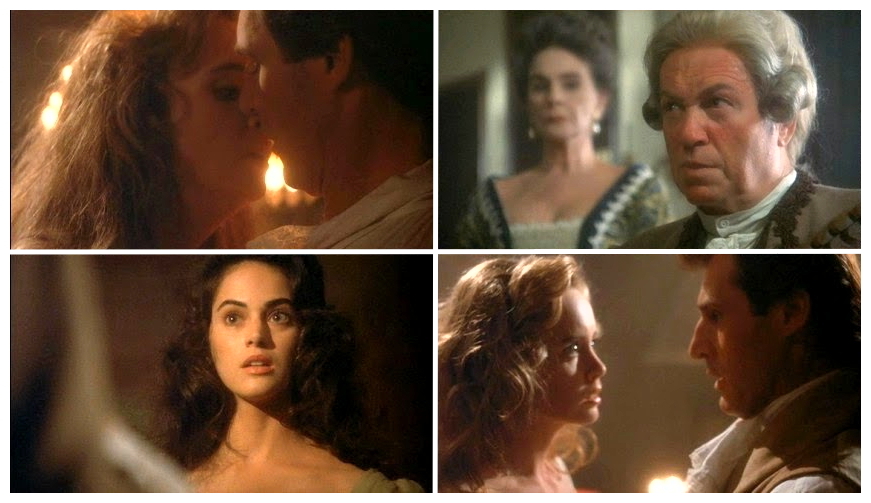
Perhaps the emphasis on horrific effects rather than on character development limited its appeal, or perhaps it’s true that a fad belongs to its own day. Whatever the reason, the revival failed to catch on, and Barnabas returned to his crypt to wait for another two decades. While Barnabas slept, filmmaker Tim Burton and actor Johnny Depp made seven popular movies together and, in 2011, decided to team up again to bring their shared fandom of the cult television series to the big screen. Burton and Depp have shared a ‘bromance’ that goes back to Edward Scissorhands (1990) when the director transformed the young star’s almost impossible prettiness into mutant Goth charm. Where John Waters gave Depp the opportunity to dip his toe into the independent film industry with Cry Baby (1990), Burton gave him full immersion and the actor is as well-known now for his oddball characters (from Captain Jack Sparrow to Hunter S. Thompson) as his straight roles.
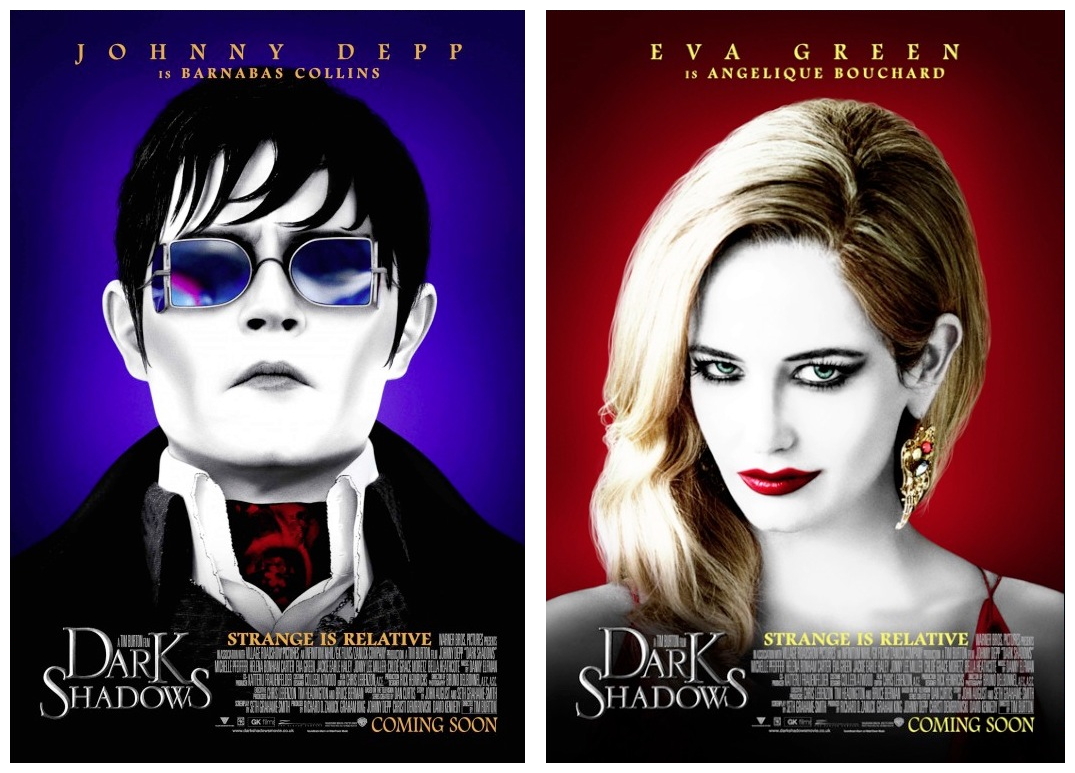
In Dark Shadows (2012) Burton revisited the sixties cult daytime soap opera that featured ghosts, werewolves and the fabulously creepy vampire Barnabas Collins, which was once condemned as ‘Satan’s favourite show’ by an over-excited critic at the time. Burton recognised that the show had created its own universe and had its own weird vibe that wasn’t like anything else. Clearly it had made an impression on him. Burton, who used to rush home to watch the show after school as a child, has built an entire oeuvre out of fabricating other worlds that are quite unlike anything else and unmistakably his own. In his feature film treatment of the series, Burton revels in the campy theatrics of daytime television while unleashing the inherent hammy humour in the over-the-top horror movies of the time, pulling out all the stops with his female cast. Helena Bonham Carter features as the Collins family’s permanent pilled-out in-house psychiatrist, Michelle Pfeiffer is a beyond-desperate housewife, and Eva Green unleashes hellish fury as Angelique, the witch that Barnabas Collins (Johnny Depp) scorned, by turning the eighteenth-century dandy into a vampire and burying him.

Two hundred years later, in the swinging early seventies, Barnabas is accidentally released and returns to the family home, now inhabited by his dysfunctional descendants, and sets about straightening them out. Unfortunately, Angelique is still at large, still madly in love with him and still refusing to take ‘no’ for an answer, which is too bad, because the Collins’ new live-in nanny Victoria Winters (Bella Heathcote) is a dead-ringer for Barnabas’ long-lost true love. There are culture-clashes aplenty when the well-heeled Barnabas finds his immortal self in the paisley-covered world of the early seventies (Alice Cooper is a particular revelation to this olde-worlde vamp). Depp sinks his fangs deep into the mesmerising role, giving a gorgeously deadpan performance as a foppish old gentleman reluctantly trapped inside a bloodsucking monster. Like Burton, Depp was also obsessed with Dark Shadows as a child and, after Warner Brothers acquired the film rights, he badgered Burton into directing it. I’m guessing that he didn’t have to twist his arm too much.
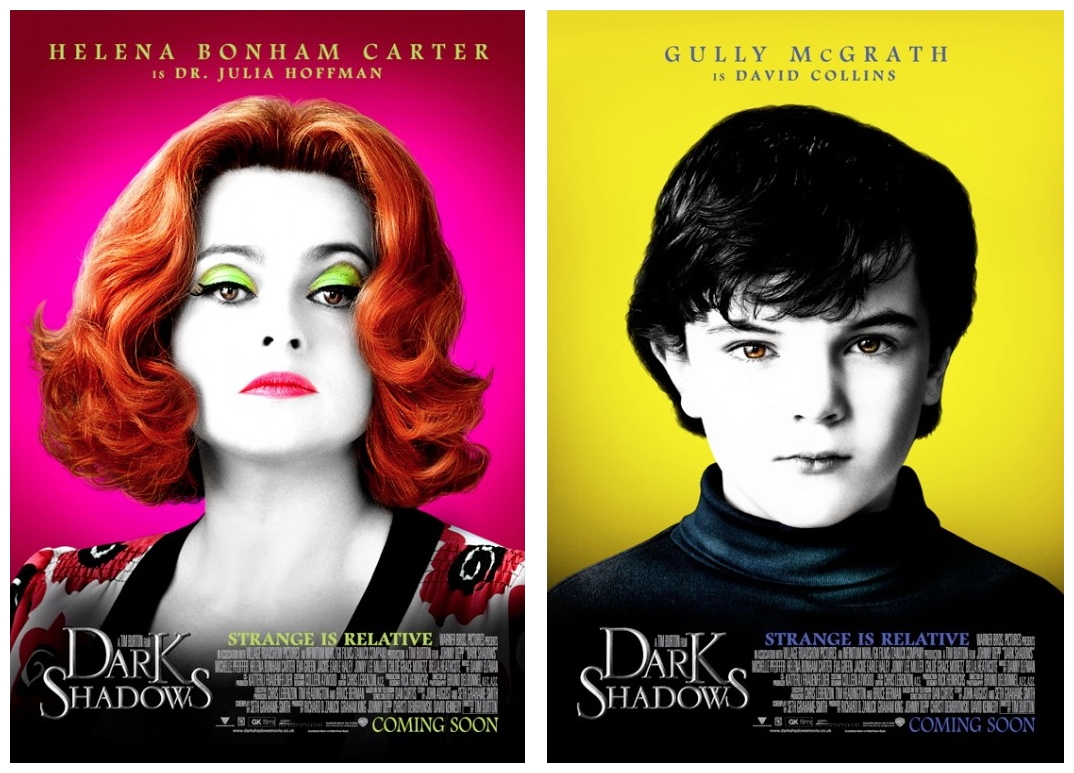
The two amigos obviously had a ball with this material, combining the warped suburban sensibility of Edward Scissorhands’ artistic vision with the screwball characterisation and humour of Ed Wood (1994), one of their best joint efforts. Other cast includes Jackie Earle Haley, Gulliver McGrath and Chloe Grace Moretz. Danny Elfman, Burton’s preferred composer, wrote and conducted the score, and Colleen Atwood designed the costumes. The 2012 film got a lot of mixed reviews from critics, some of whom appreciated its tongue-in-cheek Gothic comedy, visually appealing and a fitting adaptation of the melodramatic soapie, but some people it seems didn’t get the joke, dismissing the plot as simplistic, and that Burton and Depp’s collaborative efforts have worn thin. But, if you ask me, the result is just as weird as the original television series, but the special effects have been put under the magical spell of Burton’s transformative treatment.
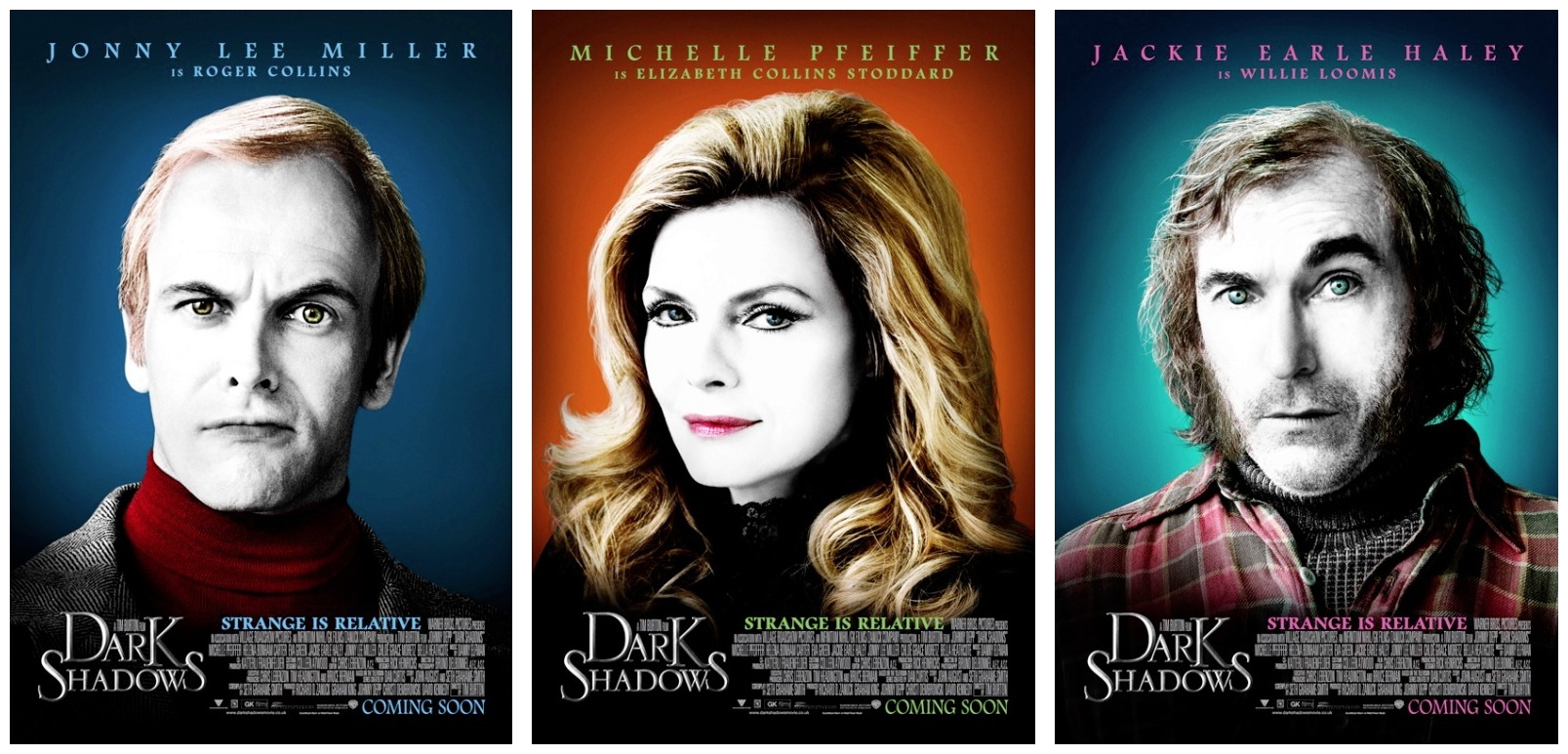
The effects are out of this world and the characters are as warped as the script’s wicked sense of humour. The film easily made its budget back at the box-office, and there were rumours going around about a sequel. Michelle Pfeiffer said in an interview that she expected a sequel, then Warner Brothers announced plans to make a sequel, and the end of the film certainly lends itself to a possible sequel. Does Tim Burton want a sequel? “No, because the nature of it being like a soap opera, that was the structure. It wasn’t a conscious decision. First of all, it’s a bit presumptuous to think that, if something works out, that’s one thing, but you can’t ever predict that. The ending had more to do with the soap opera structure of it.” I’ll be back next week come hell and high water to assault your senses with another so-called classic fetched from the deepest depths of the Los Angeles sewerage system for…Horror News! Toodles!
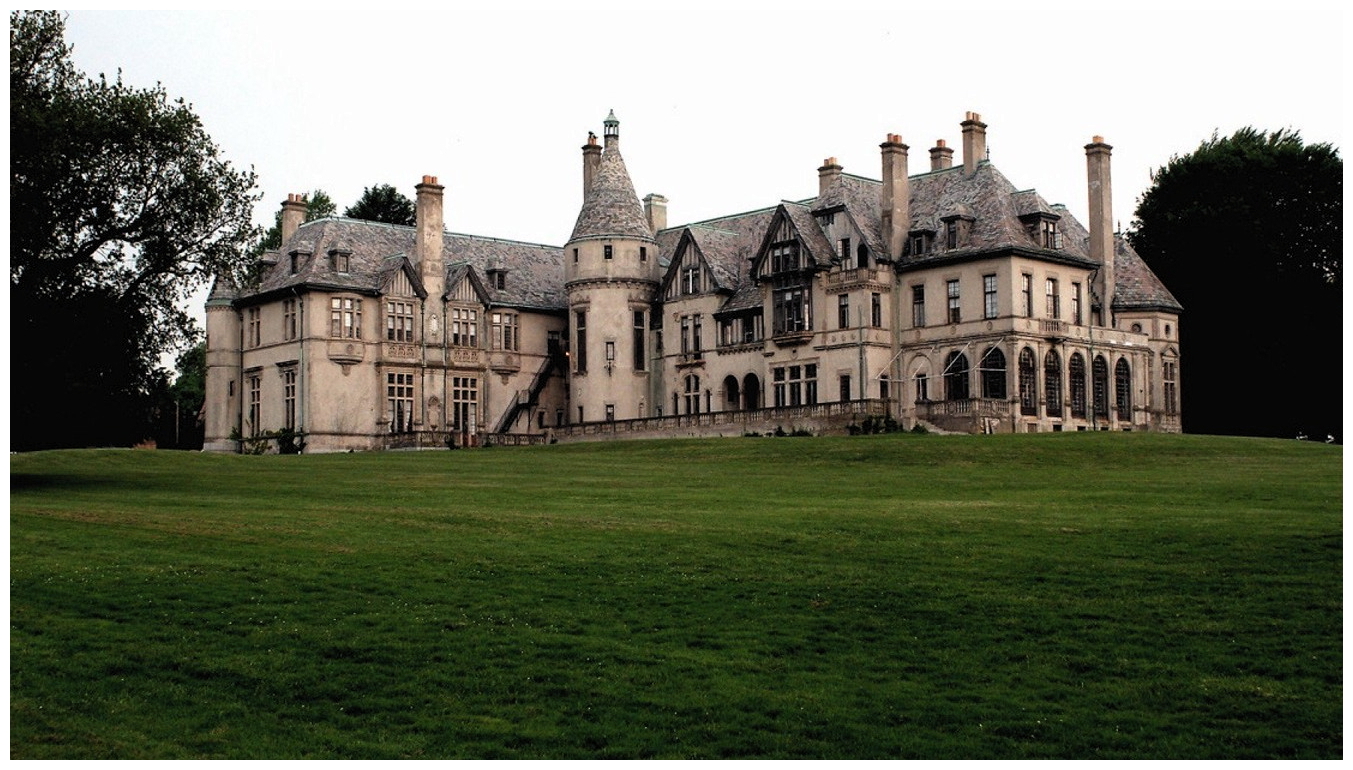
A Brief History Of Dark Shadows (1966-2012)
 Horror News | HNN Official Site | Horror Movies,Trailers, Reviews
Horror News | HNN Official Site | Horror Movies,Trailers, Reviews
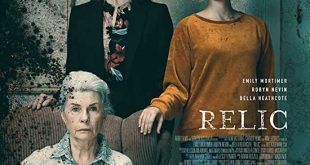
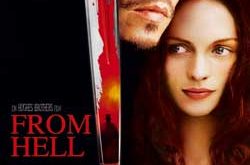


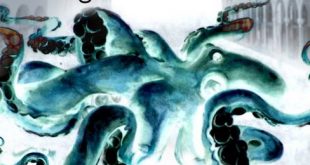
I liked the 1991 reboot but hated the modern Tim Burton version. Alexandra Moltke aka Alexandra Isles, was a key witness in the Sunny Von Bulow murder trials in the 80s.
Thanks for reading! I love this sort of trivia, sad and sordid as it is. During the early 1980s, she was subpoenaed and testified as a witness in the trial of Claus von Bülow for attempted murder of his wife, Sunny. According to newspaper accounts, Moltke and von Bülow had been having an affair. Weirdly, I was first made aware of the case through National Lampoon magazine, which had a number of amusing children’s Christmas letters addressed to ‘Santa Claus von Bülow’.
As for your dislike of the Tim Burton film, I completely understand why fans of the original show would be disappointed in Burton’s comedic take on the material. The way I had heard it, Burton wanted to do a light-hearted Addams Family-style film about Gothic family values, and Depp reminded him of Dark Shadows. I was surprised, however, by how faithful it was to the original background story and the characters (aside from Barnabas, of course) and the fact that it was set in 1972, when the last season of the original series screened. It could have been made as a more serious film, but not with Burton at the helm. That being said, it’s difficult to update some old shows without taking the comedic/parody route, The Brady Bunch Movie (1995) being a successful example.
https://www.dailymotion.com/video/x70m1p9
Don’t forget the ’95 UNAIRED pilot.